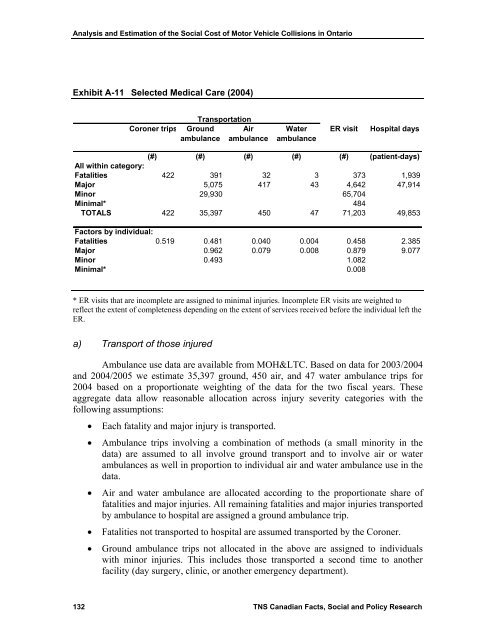Keith Vodden Dr. Douglas Smith - Transports Canada
Keith Vodden Dr. Douglas Smith - Transports Canada
Keith Vodden Dr. Douglas Smith - Transports Canada
Create successful ePaper yourself
Turn your PDF publications into a flip-book with our unique Google optimized e-Paper software.
Analysis and Estimation of the Social Cost of Motor Vehicle Collisions in Ontario<br />
Exhibit A-11 Selected Medical Care (2004)<br />
Coroner trips<br />
Transportation<br />
Ground<br />
ambulance<br />
Air<br />
ambulance<br />
Water<br />
ambulance<br />
ER visit<br />
Hospital days<br />
(#) (#) (#) (#) (#) (patient-days)<br />
All within category:<br />
Fatalities 422 391 32 3 373 1,939<br />
Major 5,075 417 43 4,642 47,914<br />
Minor 29,930 65,704<br />
Minimal* 484<br />
TOTALS 422 35,397 450 47 71,203 49,853<br />
Factors by individual:<br />
Fatalities 0.519 0.481 0.040 0.004 0.458 2.385<br />
Major 0.962 0.079 0.008 0.879 9.077<br />
Minor 0.493 1.082<br />
Minimal* 0.008<br />
* ER visits that are incomplete are assigned to minimal injuries. Incomplete ER visits are weighted to<br />
reflect the extent of completeness depending on the extent of services received before the individual left the<br />
ER.<br />
a) Transport of those injured<br />
Ambulance use data are available from MOH<C. Based on data for 2003/2004<br />
and 2004/2005 we estimate 35,397 ground, 450 air, and 47 water ambulance trips for<br />
2004 based on a proportionate weighting of the data for the two fiscal years. These<br />
aggregate data allow reasonable allocation across injury severity categories with the<br />
following assumptions:<br />
• Each fatality and major injury is transported.<br />
• Ambulance trips involving a combination of methods (a small minority in the<br />
data) are assumed to all involve ground transport and to involve air or water<br />
ambulances as well in proportion to individual air and water ambulance use in the<br />
data.<br />
• Air and water ambulance are allocated according to the proportionate share of<br />
fatalities and major injuries. All remaining fatalities and major injuries transported<br />
by ambulance to hospital are assigned a ground ambulance trip.<br />
• Fatalities not transported to hospital are assumed transported by the Coroner.<br />
• Ground ambulance trips not allocated in the above are assigned to individuals<br />
with minor injuries. This includes those transported a second time to another<br />
facility (day surgery, clinic, or another emergency department).<br />
132 TNS Canadian Facts, Social and Policy Research
















